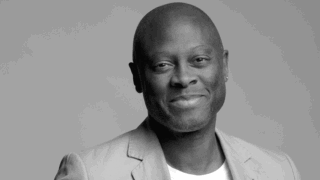- top speakers
Schools have become key players in nationwide discussions on inclusion, innovation, free speech, and…
A speakers bureau that represents the best original thinkers,
writers, and doers for speaking engagements.
The robots of the future won't require batteries. We can use simple materials to build smart, sustainable, and scalable solutions to real-world problems.
When we think of smarter environments—smarter buildings, smarter cars, smarter clothing—we generally think about adding more: more power, more cost, more complexity, and ultimately more failure, says Skylar Tibbits. Instead, we should be asking ourselves: How can we build smarter with less? As founder and co-director of the Self-Assembly Lab at MIT, Skylar has spent over a decade designing systems made from simple materials that transform themselves and adapt to their environment. Along with his collaborators, he’s created structures that respond to temperature and sunlight, textiles that adapt to body temperature, and furniture that assembles itself. Now, he’s showing you how designing for adaptation and resilience can boost innovation, climate justice, machine intelligence, and much more.
The founder and co-director of the Self-Assembly Lab at MIT, Skylar Tibbits is a designer and computer scientist whose research focuses on developing self-assembly and programmable materials within the built environment. He is an Associate Professor of Design Research in MIT’s Department of Architecture, as well as director of the undergraduate Design programs in the Department of Architecture.
Skylar has been at the cutting edge of design for over a decade. He has designed and built large-scale installations and exhibited in galleries around the world, including the MoMA, Centre Pompidou, Philadelphia Museum of Art, Cooper Hewitt Smithsonian Design Museum, Victoria and Albert Museum and various others. He is the author of Things Fall Together: A Guide to the New Materials Revolution, Self-Assembly Lab: Experiments in Programming Matter, and Active Matter, as well as co-editor of Being Material and the Editor-In-Chief of the journal 3D Printing and Additive Manufacturing.
His many awards and fellowships include LinkedIn’s Next Wave Award for Top Professionals under 35, R&D Innovator of the Year, National Geographic Emerging Explorer, an Inaugural WIRED Fellowship, the Architectural League Prize, and the Ars Electronica Next Idea Award. He was a TED Senior Fellow and was named a Revolutionary Mind by SEED magazine.
Skylar has a professional degree in architecture and a minor in experimental computation from Philadelphia University, and a masters in design computation and masters computer science from MIT. He has worked at a number of design offices including Zaha Hadid Architects, Asymptote Architecture and Point b Design.

Founding President, PlusCo Venture Studio Former Chief Creative and Innovation Officer, Cossette

Author of Jerks at Work and Job Therapy NYU Professor of Psychology
Bestselling author of Future Tense Clinical psychologist and researcher Digital health technology entrepreneur
CEO of Phylagen, Inc. TED Senior Fellow
Microsoft VP Engineering, CoreAI Computational Design & Research Author of How to Speak Machine

Global AI Advisor CEO & Co-Founder of XLabs and Ribo One of Forbes’ 30 Women in AI to Watch Artificial Intelligence Pioneer

One of America's Foremost Experts on the Declaration of Independence Award-Winning Author, Disunion Among Ourselves

Harvard Economist MacArthur Genius Studying Economic Opportunity Director of Opportunity Insights

Historian New York Times Bestselling Author of Humankind: A Hopeful History, Utopia for Realists, and Moral Ambition

Author of Grit, the #1 New York Times Bestseller | Pioneering Researcher on Grit, Perseverance, and the Science of Success

2024 Nobel Prize Winner | 3rd Most Cited Economist in the World | Bestselling Co-Author of Why Nations Fail and Power and Progress

Harvard Business School Behavioral Science Professor | "40 Under 40 MBA Professor" | Author of TALK: The Science of Conversation and the Art of Being Ourselves

#1 New York Times Bestselling Co-Author of Abundance | Host of thePlain English Podcast | Founder of the Substack Derek Thompson

#1 New York Times Bestselling Author of How the Word Is Passed and Above Ground | The Atlantic Staff Writer

Instead of designing smart solutions that require more cost, more complexity, and more risk, can we design smarter with less? Skylar Tibbits says yes.
For over a decade, the founder of MIT’s Self-Assembly Lab has been using simple materials and natural forces like gravity and time to create smart solutions to our real-world problems. Think: a sweater that adapts to your body temperature, or a chair that can refit itself to what you need.
In this keynote, Skylar argues that if we change the way we think about designing products and environments, we’ll be better equipped to meet the challenges of innovation and sustainability that have become crucial for every organization. He offers fascinating stories and insights from his own work: like how his team is using simple geometric shapes to form sandbars and mitigate the effects of climate change on coastal regions. Skylar shows us how soon these small-scale technologies will translate into solutions for large-scale applications—and what it means for your organization, industry, and society as a whole.